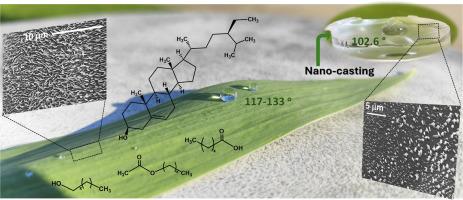Iris sibirica leaf surface: From plant adaptation to biomimetic replication
IF 6.3
2区 材料科学
Q2 CHEMISTRY, PHYSICAL
引用次数: 0
Abstract
The present study highlights the vast wealth of information that may be retrieved from the surface of plant leaves, allowing researchers to harmoniously combine concepts from physical chemistry, biology, and plant science, with materials science and engineering, in the development of functional coatings and engineered films. The primary goal of this work was to conduct a comprehensive chemical, morphological, structural, optical, histological, potential distribution, and climatic characterization of Iris sibirica L. leaves. With it, three main axes of research are here reported and discussed: the physical-chemistry of the I. sibirica leaf cuticles, its environmental correlation, and the replication of its hydrophobic properties aiming at future applications. The chemical analysis of the intracuticular and epicuticular waxes on the leaf surfaces of I. sibirica revealed the presence of fatty acids (mainly palmitic and stearic acids), long-chain aliphatic alcohols, and sterols.
Comparison with previous studies enabled a biogeographical distinction between species with higher concentrations of ketones and those richer in alcohols. However, no significant discrimination was observed in the physical chemical parameters such as morphology and wettability. These findings highlight the sophisticated strategies plants use to adapt to environmental changes. Furthermore, the replication of the hydrophobic properties of the I. sibirica leaf surfaces in a transparent and self-standing di-ureasil hybrid film using a nanocasting approach was achieved. The water contact angle (CA) of the leaf-imprinted di-ureasil films demonstrated an impressive enhancement compared to the flat sample analog (97.4 ± 1.6 and 66.3 ± 5.6°, respectively), confirming the key role played by surface microstructure in determining wettability. However, the CA of the biomimetic film replicas remained lower than that of the natural leaf (117–133°), reinforcing the claim that surface wax composition is also pivotal.

西伯利亚虹膜叶表面:从植物适应到仿生复制
目前的研究强调了可以从植物叶片表面检索到的大量信息,使研究人员能够将物理化学,生物学和植物科学的概念与材料科学和工程的概念和谐地结合起来,以开发功能涂层和工程薄膜。本研究的主要目的是对西伯利亚鸢尾叶片的化学、形态、结构、光学、组织学、潜在分布和气候特征进行全面的研究。在此基础上,本文报道并讨论了三个主要的研究方向:西伯利亚叶面角质层的物理化学性质、环境相关性以及疏水特性的复制,以期将来的应用。对叶面表皮蜡质和角质层蜡质进行化学分析,发现含有脂肪酸(主要是棕榈酸和硬脂酸)、长链脂肪醇和甾醇。与先前的研究进行比较,可以在酮类浓度较高的物种和醇类含量较高的物种之间进行生物地理区分。然而,在物理化学参数(如形态和润湿性)上没有观察到明显的区别。这些发现突出了植物用来适应环境变化的复杂策略。此外,利用纳米浇铸的方法,在透明、自立的双脲醇混合膜中复制了西伯利亚叶面的疏水性。与平面样品模拟物相比,叶印迹双脲醇膜的水接触角(CA)显著增强(分别为97.4±1.6°和66.3±5.6°),证实了表面微观结构在决定润湿性中的关键作用。然而,仿生膜复制品的CA仍然低于天然叶片(117-133°),这加强了表面蜡成分也是关键的说法。
本文章由计算机程序翻译,如有差异,请以英文原文为准。
求助全文
约1分钟内获得全文
求助全文
来源期刊

Surfaces and Interfaces
Chemistry-General Chemistry
CiteScore
8.50
自引率
6.50%
发文量
753
审稿时长
35 days
期刊介绍:
The aim of the journal is to provide a respectful outlet for ''sound science'' papers in all research areas on surfaces and interfaces. We define sound science papers as papers that describe new and well-executed research, but that do not necessarily provide brand new insights or are merely a description of research results.
Surfaces and Interfaces publishes research papers in all fields of surface science which may not always find the right home on first submission to our Elsevier sister journals (Applied Surface, Surface and Coatings Technology, Thin Solid Films)
 求助内容:
求助内容: 应助结果提醒方式:
应助结果提醒方式:


